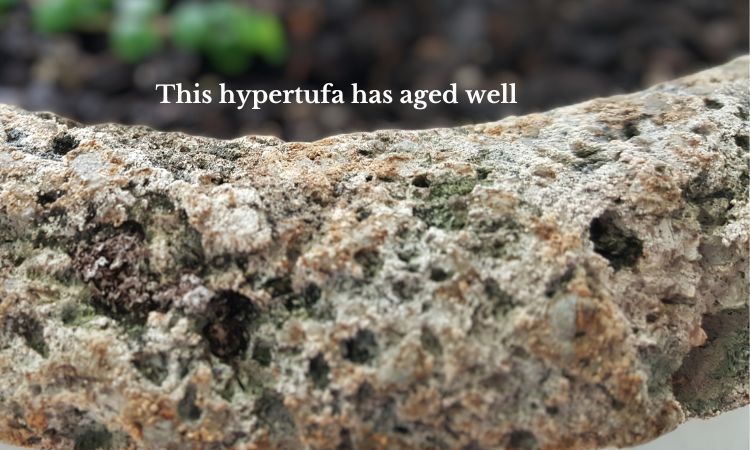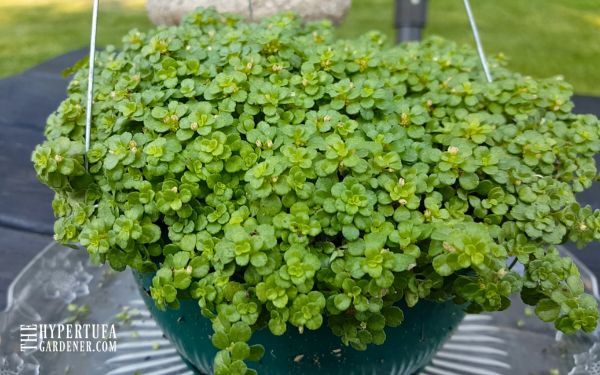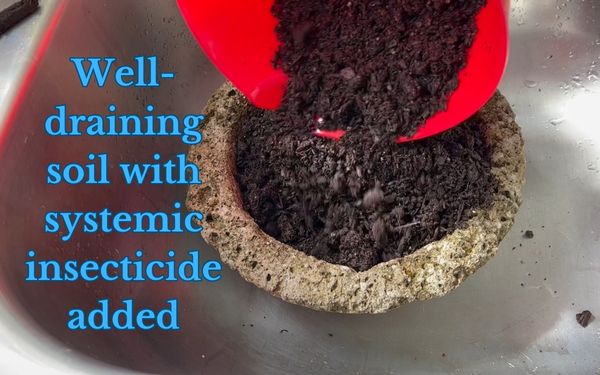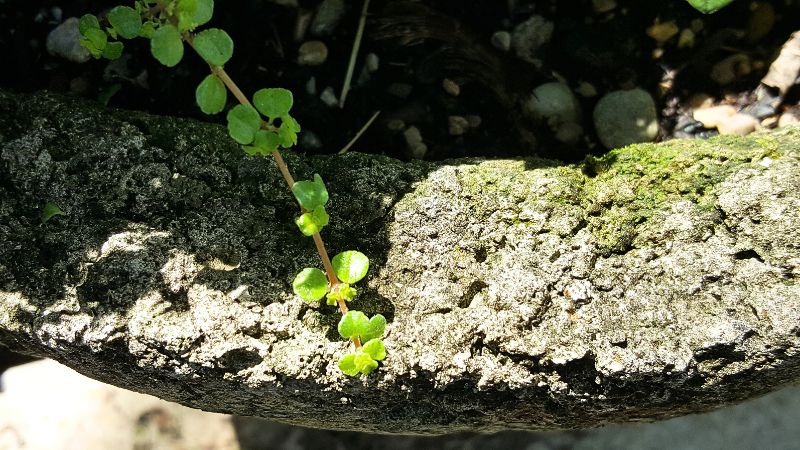Baby Tears In Hypertufa Is Awesome!
Propagating Baby Tears (Soleirolia soleirolii) in hypertufa containers is a great way to create charming and unique mini-gardens. The tiny green leaves creeping over the top and cascading down the sides is such a wonderful sight.
I have grown them in hypertufa before and love that look. But this time I am creating another new one for an indoor houseplant in my hypertufa bowl.

Soleirolia soleirolii or Baby Tears is a low-growing perennial native to the Mediterranean region. It has intricate foliage consisting of tiny, round leaves that cascade down stems, creating a lush, carpet-like effect.
The plant’s common names, Baby Tears and Angels Tears reflect its tendency to rapidly fill in spaces and cover the ground, giving it a dense and delightful appearance.

This beautiful foliage plant is, in my mind, perfect for hypertufa but in the opposite way we usually look at it for succulent plants or cacti. Baby Tears need constant moisture but not soggy soil. Therefore it needs a soil mix and container that will help keep moisture drained away.
Voila….hypertufa! A match made in heaven.

All those tiny nooks and crannies in the hypertufa will keep the soil from being soggy, but also the hypertufa itself can be moistened and hold water therefore keeping the surrounding soil wicked with moisture.
And when I grow a plant like Baby Tears in hypertufa, I can water to my heart’s content. I typically put a large glass plate under the hypertufa planter and keep that underplate with a bit of water. Of course, not to make soggy, but to keep it moist at all times.

This Baby Tears plant has lived outdoors this summer, but I want to bring it inside. This is the perfect time to treat it with my Bonide Systemic Insecticide. I use this for treating for all kinds of insects that may come in with my plants coming inside.
I have a post about the Systemic Treatment of potted indoor plants. This has worked for me for several years. Years ago, I had a cloud of gnats all “hatch” at the same time and had what looked like pepper sprinkled across the ceiling!
That was a monumental battle. Never in my life since then have I ever seen so many!

Advantages of Hypertufa for Moisture Loving Houseplants
Hypertufa is a mixture used to create artificial stone-like containers and garden ornaments. It is commonly used for planting containers, and can be especially suitable for plants that prefer higher moisture levels. The advantages of using hypertufa containers for moisture-loving plants include:
Porosity: Hypertufa containers are porous in nature due to the specific mixture of cement, peat moss, and perlite or other aggregates. This porosity allows excess moisture to escape, preventing waterlogged soil and root rot, which can be detrimental to many moisture-loving plants.
Moisture Regulation: While hypertufa containers can hold moisture, they also allow for efficient drainage. This balance helps in maintaining consistent moisture levels within the container, avoiding the extremes of either excessive dryness or over-saturation.

Air Circulation: The porous nature of hypertufa provides improved air circulation to the roots. This can prevent the growth of molds and fungi that thrive in overly moist and stagnant conditions, contributing to the overall health of moisture-loving plants.
Customization: Hypertufa containers can be handmade, allowing you to create containers of various shapes, sizes, and textures. This customization ensures that you can tailor the container to the specific needs of your moisture-loving plants, accommodating their root systems and growth patterns.
Aesthetic Appeal: The natural and rustic appearance of hypertufa containers complements the lush and vibrant appearance of moisture-loving plants. The containers can mimic the look of stone or aged pottery, enhancing the visual appeal of your garden.

Insulation: Hypertufa containers provide some level of insulation for plant roots, helping to protect them from temperature fluctuations. This can be particularly beneficial for moisture-loving plants that might be sensitive to rapid changes in temperature.
Suitable Growing Environment: Hypertufa containers are ideal for creating micro[-environments that mimic natural habitats for moisture-loving plants. The porous nature of the containers allows them to more closely replicate the conditions these plants would experience in the wild.
Sturdiness: While hypertufa containers are lightweight compared to solid stone containers, they still provide enough weight and stability to prevent toppling over in windy conditions. This ensures the safety and stability of your plants.
Here’s a video of my planting this hypertufa bowl with Baby Tears.
So if you would like to try it, the advantage of using hypertufa containers for moisture-loving plants lies in their porosity, moisture regulation, air circulation, and customization capabilities. These factors collectively create a conducive environment for the healthy growth of plants that thrive in higher levels of moisture.
Just like these gorgeous Baby Tears! As you see in the video, mine will live in the plastic bag for a week or so until I can believe no “hitchhikers” came inside. The soil was treated with Bonide Systemic Insecticide so I should be good to go!


